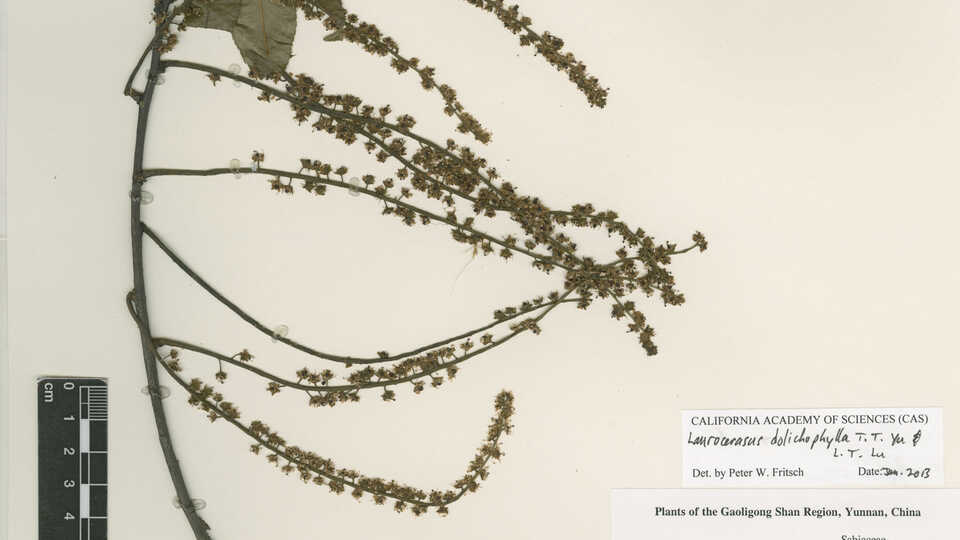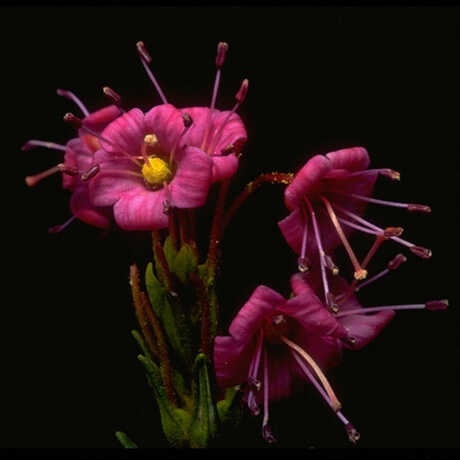Learn more about our department's century and a half of scientific history.

The herbarium of the California Academy of Sciences is the largest collection of vascular plants in the western U.S. It is the sixth largest collection in the United States. Together with the Herbarium of the University of California at Berkeley (UC) the San Francisco Bay area is regarded as a National Resource Center for systematic botany. These two major collections have an informal agreement to avoid duplication, thus providing botanists with a rich and varied resource for research.
Search Our Collections:
- Search Consortium of California Herbaria (CCH2)
- Search Botany Collection Database (GBIF)
- Search Integrated Digitized Biocollections (iDigBio)
User Guides:
Accessing the Collection
The Botany collection is available for study by qualified researchers, Botany students and professionals in the field by appointment only. To determine if our collection contains specimens from your taxonomic group, or which might prove useful to your research, please visit our online collection database which is searchable by taxon, collector, geography and other selected criteria.
If you would like to arrange a visit to view specific specimens/groups, please contact the Botany Collection Manager (details on main page) via email and include a brief research proposal and list of the specimens you would like to see. For students, also include a letter of support from a faculty member.
More About the Collections
The Academy collection includes approximately 2 million plant specimens. More than 95% of the specimens are vascular seed plants; the remainder are ferns and a growing collection of bryophytes. In addition to the general collection which includes type specimens, there are over 18,000 types (holotypes, isotypes, syntypes, lectotypes, and neotypes) housed separately.
The collection was built largely as the result of research collections by the curators and staff of the Academy and the Dudley Herbarium (DS) and augmented by purchases, exchanges, and bequests made over the years. The collection is strongest in vascular plants from North and Latin America (particularly California and western and southern Mexico) and the Galapagos Islands, as well as important collections from other areas of the world. Some vascular plant families and genera that are especially well represented are Acanthaceae, Brassicaceae, Carex, Eriogonum, Hydrophyllaceae, Lupinus, Madinae (Asteraceae), Malvaceae, Melastomataceae, Onagraceae, Penstemon, Poaceae, Polemoniaceae, and Quercus. The herbarium also includes the largest collection of ornamental plants in California.
The main focus for growth presently involves the acquisition of plants from Latin America (particularly Mexico, Central America, and northern South America), Eastern Asia (particularly China), and Western North America (particularly California, Nevada, and Arizona).
How to Search the Botany Collection
Quick tips on how to search the collections database:
1. Our collections database is not case sensitive
2. Use either an "*" or "%" as a wildcard
Currently the Botany database contains records for more than 675,000 of our specimens. The following portions of our collection are included in the database: 1) Types; 2) Modoc County, California; 3) Dennis Breedlove's collections from Chiapas, Mexico; 4) Yunnan Province, China; 5) California ferns, gymnosperms, woody angiosperms, monocots, and 75% of the remaining vascular plant families including Asteraceae; 6) Melastomataceae; 7) Recent collections from Latin American and Madagascar. We are currently adding: Euphorbiaceae and Apocynaceae/Asclepiadaceae as part of the Endless Forms TCN grant and Scrophulariaceae s.l.
We follow Flora of North America nomenclature for all U.S. collections, Flora of China and Flora of Japan, and Flora Mesoamericana.
If you are searching for these records and are having trouble finding what you need, try limiting your search to as little information as possible (e.g., ONLY genus and species or only family).If you are searching for images of Type specimens, Melastomataceae, or Yunnan specimens, please search using Monarch. Monarch is a Symbiota database.
Destructive Sampling Policy
The collections of the CAS/DS herbaria are maintained with the goal of balancing preservation of the integrity of herbarium specimens with utilization for scientific research. No destructive sampling is allowed until permission is granted to the person institutionally responsible for the receipt of the specimens. In order to request permission, please download the request form and return a completed, signed copy to the department as instructed on the form.
Terms of Use
These databases and all images within them are owned and copyrighted by the California Academy of Sciences, ©2009, or licensed to it. The data and images may be used freely by individuals and organizations for purposes of basic research, education and conservation. These data and images may not be used for commercial or for-profit purposes without the express written consent of the California Academy of Sciences, and may not be repackaged, resold, or redistributed in any form.
Use of the data or images in publications, dissertations and theses, or other scientific reports, should be accompanied by an acknowledgement of the Department of Botany, California Academy of Sciences, as the source for the information. Please provide the Department with separates of articles resulting from the use of these data or images. This helps us to document the use of specimens as “vouchers” in the literature. It also helps us to justify continued funding for the collections so that these resources remain available into the future.
Share This
Visiting our collections, identifying backyard plants, and more.
View sample labels for vascular plants.
Collections inquiries:
Emily Magnaghi
Collection Manager
California Academy of Sciences
55 Music Concourse Dr.
San Francisco, CA 94118
emagnaghi@calacademy.org
(415) 379-5392
Search our popular California Wildflowers database by color, or by common, Latin, or family name.
